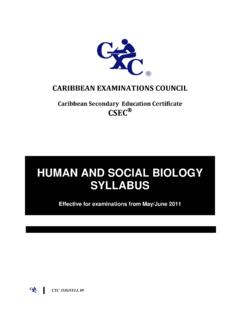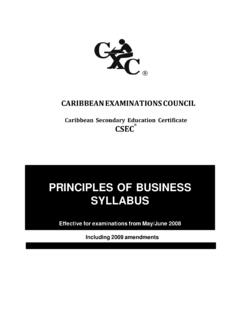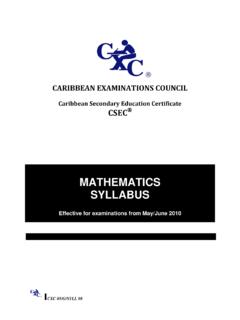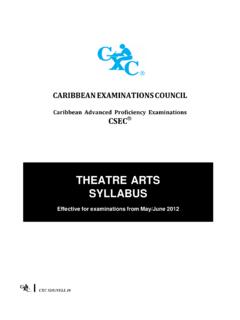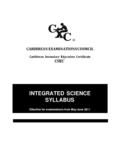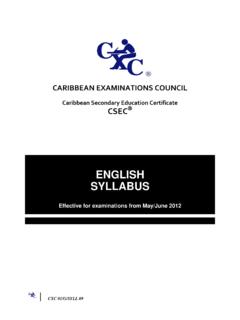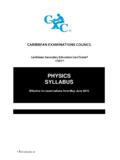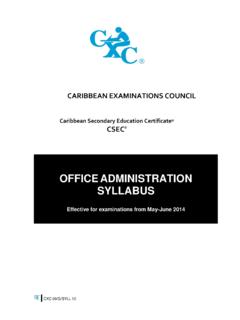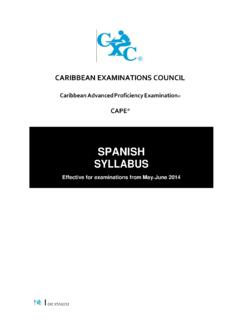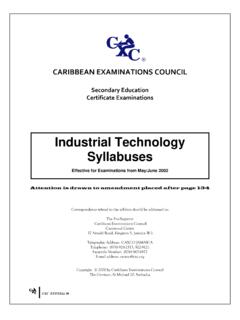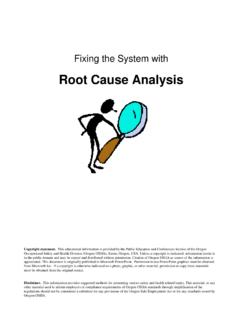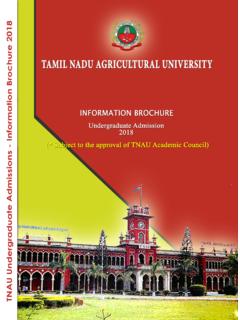Transcription of INFORMATION TECHNOLOGY SYLLABUS - CXC | Education
1 CARIBBEAN EXAMINATIONS COUNCIL. Caribbean Secondary Education Certificate CSEC.. INFORMATION TECHNOLOGY . SYLLABUS . Effective for examinations from May/June 2010. C XC 30/G /S YLL 08 1. Published by the Caribbean Examinations Council All rights reserved. No part of this publication may be reproduced, stored in a retrieval system, or transmitted in any form, or by any means electronic, photocopying, recording or otherwise without prior permission of the author or publisher. Correspondence related to the SYLLABUS should be addressed to: The Pro-Registrar Caribbean Examinations Council Caenwood Centre 37 Arnold Road, Kingston 5, Jamaica, Telephone: (876) 630-5200.
2 Facsimile Number: (876) 967-4972. E-mail address: Website: Copyright 2008, by Caribbean Examinations Council The Garrison, St Michael BB14038, Barbados CXC 30/G/SYLL 08. Contents RATIONALE .. 1. AIMS .. 2. ORGANIZATION OF THE SYLLABUS .. 2. SUGGESTED TIME-TABLE ALLOCATION .. 2. FORMAT OF THE EXAMINATIONS .. 3. CERTIFICATION AND DEFINITION OF PROFILE 4. HARDWARE AND SOFTWARE 5. NOTES TO TEACHERS .. 5. REGULATIONS FOR RESIT 7. REGULATIONS FOR STUDENTS FROM PRIVATE INSTITUTIONS .. 7. SECTION 1 FUNDAMENTALS OF HARDWARE AND SOFTWARE .. 8. SECTION 2 PROBLEM-SOLVING AND PROGRAM DESIGN .. 10. SECTION 3 PROGRAM IMPLEMENTATION .. 12.
3 SECTION 4 APPLICATIONS AND IMPLICATIONS OF INFORMATION AND. COMMUNICATIONS TECHNOLOGY .. 13. SECTION 5 INFORMATION PROCESSING .. 15. SECTION 6 WORDPROCESSING, PRESENTATION AND WEB PAGE DESIGN .. 16. SECTION 7 19. SECTION 8 DATABASE 21. GUIDELINES FOR THE CONDUCT OF THE SCHOOL BASED 23. RECOMMENDED TEXTS .. 46. 47. CXC 30/G/SYLL 08. ii This document CXC 30/G/SYLL 08 replaces CXC 30/G; T/SYLL 00A issued in 2000. Revised 2000, 2008, 2013. Please check the website, for updates on CXC's syllabuses. CXC 30/G/SYLL 08. iii INFORMATION TECHNOLOGY SYLLABUS RATIONALE. INFORMATION TECHNOLOGY has evolved over the past five decades in response to the need for more efficient techniques to manage the significantly increased volume and sophistication of the knowledge reservoir of mankind.
4 It merges the study of Computer Science, Telecommunications and Office Automation; involves the collection, storage, accessing, processing and dissemination of INFORMATION and impacts on both work and leisure activities. In a world characterised by technological innovation and computerized responses to situations in the work place and in the wider society, all citizens will need to have practical exposure to the techniques of INFORMATION TECHNOLOGY in order to bridge the widening gap between Caribbean nations and the developed countries and provide our citizens with the best chances for survival and growth in this new age. A structured programme in INFORMATION TECHNOLOGY develops computer-related skills and encourages the development of analytical and design skills which are applicable in all areas of the curriculum.
5 This unique feature warrants the inclusion of INFORMATION TECHNOLOGY in the secondary school curriculum. This SYLLABUS is designed to provide a coherent view of the significance of INFORMATION in a socio-economic context. Emphasis is placed on application of knowledge and the use of the computer. This approach has been adopted in recognition of the impact that changes in the availability of INFORMATION can have on the educational process. The focus is on getting students to develop skills for life in an increasingly technological world, rather than on students absorbing a myriad of seemingly unrelated facts which may have only short term relevance.
6 The SYLLABUS aims to provide the kind of practical experience which includes an element of discovery, and fosters self-confidence, together with the practical skills that will prepare students to meet the region's need for greatly increased productivity and cost effective procedures. The INFORMATION TECHNOLOGY SYLLABUS is based on objectives, skills and content which will cultivate the attributes of the Ideal Caribbean Person as articulated by CARICOM. That is, a Caribbean person who demonstrates multiple literacies, as well as independent and critical thinking. The individual questions the beliefs and practices of the past and brings this to bear on the innovative application of science and TECHNOLOGY to problem solving.
7 Such a person will inevitably demonstrate a high level of self-confidence and self-esteem, a positive work ethic, and display and nurture creative imagination in the economic and entrepreneurial spheres and other areas of life. Also, in keeping with the UNESCO Pillars of Learning, this course of study will contribute to the development of a person who will learn to be, learn to know, learn to do, learn to live together, and learn to transform oneself and society. CXC 30/G/SYLL 08 1. AIMS. The SYLLABUS aims to: 1. prepare students to function effectively in a dynamic technological era;. 2. promote the development of computer-related skills for immediate application to other curricular areas.
8 3. provide a foundation for post-secondary Education ;. 4. facilitate the development and application of problem-solving skills in students. ORGANIZATION OF THE SYLLABUS . The SYLLABUS is organised under eight main sections. 1. Fundamentals of Hardware and Software 2. Problem-Solving and Program Design 3. Program Implementation 4. Applications and Implications of INFORMATION and Communications TECHNOLOGY 5. INFORMATION Processing 6. Wordprocessing, Presentation and Web Page Design 7. Spreadsheets 8. Database Management SUGGESTED TIME-TABLE ALLOCATION. It is estimated that the SYLLABUS can be covered in approximately 160 hours or 4 periods per week during the fourth and fifth years in the secondary school.
9 A suggested time allocation (in hours) is shown below for each section. The laboratory hours indicated are calculated on a per student basis. CXC 30/G/SYLL 08. 2. Section Class Lab Field Total 1. Fundamentals of Hardware and 18 4 2 23. Software 2. Problem-Solving and Program Design 7 15 - 22. 3. Program Implementation 15 20 - 35. 4. Applications and Implications 11 - 2 13. of INFORMATION and Communications TECHNOLOGY 5. INFORMATION Processing 12 - - 12. 6. Wordprocessing, Presentation 5 15 - 20. and Web Page Design 7. Spreadsheets 5 10 - 15. 8. Database Management 5 13 - 18. Allied Subjects Although no subjects are being specified as either prerequisites or co-requisites to INFORMATION TECHNOLOGY , it is expected that students would have pursued a course in Mathematics up to Grade 9 (Form 3).
10 FORMAT OF THE EXAMINATIONS. Pa p e r 0 1 Sixty multiple choice items drawn from all areas of the SYLLABUS . (1 hour 30 minutes). Pa p e r 0 2 Twelve compulsory structured questions drawn from all areas of the SYLLABUS , divided (2 hours 15 minutes) into three sections. Section 1 is worth 60 marks and consists of six short answer questions. Section 2 is worth 15 marks and consists of two structured questions. Section 3 is worth 45 marks and consists of four structured questions. Sc h o o l B as e d A s s e s s m e n t Paper 03 The SBA component will comprise a practical project testing: Section 2, Problem-Solving and Program Design; Section 3, Program Implementation; Section 6, Wordprocessing; Section 7, Spreadsheets and Section 8, Database Management.
